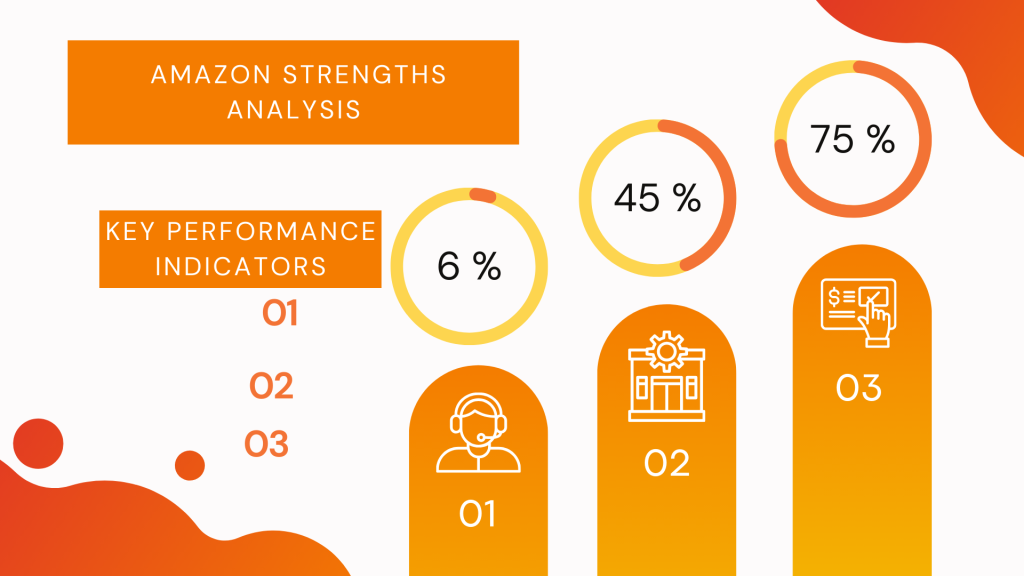In-Depth Amazon SWOT Analysis: A Comprehensive Guide
About Amazon
Amazon is one of the world’s largest and most successful e-commerce companies, offering a wide range of products and services to customers around the world.
With a market capitalization of over $1.5 trillion as of 2021, Amazon is a leader in the e-commerce space and has a significant impact on the global economy.
Amazon in a table summary, including key financial information:
| Company Overview | |
|---|---|
| Company Name | Amazon.com, Inc. |
| Founded | July 5, 1994 |
| Founders | Jeff Bezos |
| Headquarters | Seattle, Washington, U.S. |
| Industry | E-commerce, Cloud Computing, Artificial Intelligence, Digital Streaming, Consumer Electronics |
| Key Products/Services | Amazon.com (Online Retail), Amazon Web Services (Cloud Computing), Amazon Prime (Subscription), Kindle, Alexa, Amazon Video, Amazon Music, Audible, Ring, Eero, Zoox (Self-Driving Cars) |
| CEO | Andy Jassy (since July 2021) |
| Employees | 1.6 million (as of Dec 2022) |
| Financial Highlights (FY 2022) | |
|---|---|
| Revenue | $514.0 billion |
| Net Income | $33.4 billion |
| Total Assets | $421.6 billion |
| Market Capitalization | ~$1.0 trillion (as of March 2024) |
| Operating Cash Flow | $53.7 billion |
| R&D Expenditure | $71.3 billion |
This article will provide a comprehensive SWOT analysis of Amazon, identifying the strengths, weaknesses, opportunities, and threats that the company faces.
Strengths of Amazon
Wide range of products and services: Amazon offers a wide range of products and services, including books, electronics, clothing, and food, among others. This breadth of offerings helps to attract and retain customers.
Strong brand recognition: Amazon is a well-known and highly-regarded brand, with strong recognition among consumers around the world.

Logistics and distribution network: Amazon has a sophisticated logistics and distribution network that enables it to deliver products to customers quickly and efficiently.
Logistics network: Amazon has an extensive logistics network that allows the company to deliver products quickly and efficiently. This has helped Amazon maintain its competitive edge and attract more customers.
Dominance in the e-commerce space: Amazon has a dominant position in the e-commerce space, with a large share of the market and a large customer base.
Diversified product portfolio: Amazon offers a vast range of products, from books and electronics to groceries and household items. This has allowed the company to attract a large customer base and maintain its position as a market leader.
Advanced technology: Amazon invests heavily in technology and innovation. This has allowed the company to offer its customers a seamless shopping experience and stay ahead of the competition.
Global reach: Amazon operates in multiple countries and has a large international customer base. This has allowed the company to tap into new markets and increase its revenue.
Weaknesses of Amazon
Dependence on third-party sellers: Amazon relies heavily on third-party sellers to provide a significant portion of its product offerings. This dependence on third parties can lead to challenges with product quality and delivery times.
Limited physical retail presence: Despite its success in the e-commerce space, Amazon has a limited physical retail presence, which may limit its ability to attract customers who prefer to shop in brick-and-mortar stores.
Cost structure: Amazon’s cost structure, including investments in new initiatives and the cost of delivering packages, can be high and may limit profitability.
Competition from traditional retailers: Despite its dominance in the e-commerce market, Amazon still faces competition from traditional retailers who are expanding their online presence.
High operating costs: Amazon’s investments in technology, logistics, and innovation have led to high operating costs. This puts pressure on the company’s profit margins and affects its overall financial performance.
Opportunities of Amazon
Expansion into new markets: Amazon has the opportunity to expand into new markets, both domestically and internationally, to increase its customer base and revenue.
Diversification into new product and service offerings: Amazon has the opportunity to diversify into new product and service offerings, such as healthcare and financial services, to increase its revenue and customer base.
Integration with other products and services: Amazon has the opportunity to integrate its platform with other products and services, such as smart home devices and voice-activated assistants, to provide a more comprehensive customer experience.
Investment in new technologies: Amazon has the opportunity to invest in new technologies, such as artificial intelligence and robotics, to improve its operations and stay ahead of the competition.
Expansion into new business segments: Amazon has the opportunity to expand into new business segments, such as cloud computing and advertising, to diversify its revenue streams and reduce its dependence on its core business.
Threats of Amazon
Competition from other e-commerce companies: Amazon faces intense competition from other e-commerce companies, such as eBay and Walmart, which may limit its market share and profitability.
Increasing regulatory scrutiny: Amazon may face increased regulatory scrutiny, both in the US and internationally, which could limit its ability to operate and generate revenue.
Cybersecurity threats: Amazon is vulnerable to cybersecurity threats, including hacking and data breaches, which could harm the company’s reputation and lead to financial losses.
Competition from new players: Amazon faces competition from new players in the e-commerce market who are leveraging technology and innovation to offer customers a better shopping experience.
Regulatory challenges: Amazon operates in a highly regulated industry, and changes in regulations can have a significant impact on the company’s operations.
Economic downturns: Economic downturns can lead to a decrease in consumer spending, which can negatively impact Amazon’s revenue.
Conclusion
In conclusion, Amazon faces both strengths and challenges as it continues to grow and expand. The company’s wide range of products and services, strong brand recognition, and logistics and distribution network are strengths, while its dependence on third-party sellers, limited physical retail presence, and high cost structure are weaknesses.
Amazon has opportunities to expand into new markets, diversify into new product and service offerings, and integrate its platform with other products and services, while facing threats from competition, increasing regulatory scrutiny, and cybersecurity threats.
To remain successful, Amazon must carefully navigate these strengths, weaknesses, opportunities, and threats to continue its growth and success.



